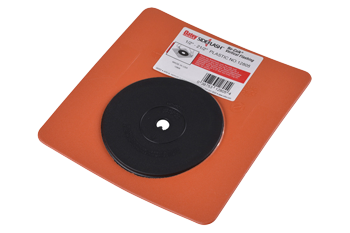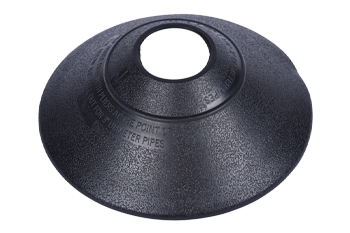Roof flashings play a vital role in ensuring the integrity and longevity of a building’s roof. Made from durable materials such as metal, rubber, or plastic to withstand harsh weather conditions and resist corrosion, flashings prevent water or moisture from seeping into roofing joints or intersections, such as chimneys, vent pipes, or skylights. By creating a watertight barrier, roof flashings effectively redirect water away from vulnerable areas, preventing potential damage to the building’s roofing structure, insulation, and interior.
In short, roof flashings are essential in any roofing system and should be carefully designed and installed by professionals to ensure long-lasting protection. By strategically sealing vulnerable areas, roof flashings safeguard the investment in a roofing project while ensuring the structural integrity of the entire building.
Fun fact: In 1916, Oatey established its first manufacturing plant and corporate headquarters on Berea Road in Cleveland, Ohio. The first product made there was a roof flashing.
What are the different types of roof flashings?
Oatey flashings are engineered to withstand demanding conditions. Rated for a minimum continuous heat resistance of 180° F, Oatey roof flashings are suitable for Type B Installations, giving users peace of mind regarding performance and durability.
Note: Type B installations are a specific type of installation that requires careful consideration of safety measures and specialized techniques.
In addition to standard flashings, Oatey also offers specialty items designed to meet specific needs. The Master Flash is an excellent choice for commercial applications, while Side and Solar Flashings provide tailored solutions for unique situations.
Below is a breakdown of the different types of roof flashings offered by Oatey:
Standard Flashings
Standard roof flashings are typically made from durable materials such as metal, rubber, or plastic, chosen for their ability to prevent water infiltration and resist corrosion even in harsh weather conditions.
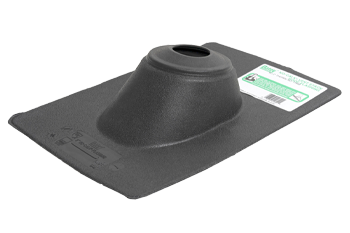
One common type is the chimney flashing, installed around the base of a chimney to prevent water from seeping into the roof joint. This flashing typically consists of metal sheets or shingles layered around the chimney, creating a barrier that redirects water away from the vulnerable intersection.
Another commonly used standard flashing is the vent pipe flashing that seals the area around plumbing vent pipes that protrude through the roof. They help prevent water from entering the roof and maintain the roofing system's integrity. Vent pipe flashings are often made of flexible materials such as rubber or thermoplastic, allowing for easy installation and flexibility in accommodating various pipe diameters.
Multi-Size Flashings
Multi-size flashings are specifically designed to accommodate round plumbing pipe penetrations. The appeal of using a multi-size flashing is that one flashing can cover multiple sizes, which means an installer does not necessarily need to know what exact size they are working with. Currently, Oatey offers 1.5”, 2” and 3” in one flashing, and 3” and 4” in another flashing.
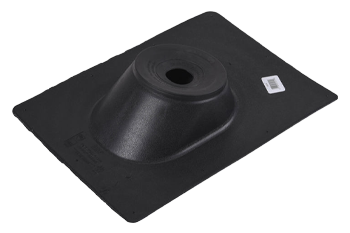
With adjustable features or multiple sizing options, these flashings are easily customized to fit different penetration diameters, ensuring a watertight seal and preventing leaks. This versatility makes them a popular choice for residential and commercial roofing projects.
Using multi-size flashings eliminates the need for custom or specialty flashings, making them convenient, efficient, and cost-effective without sacrificing performance or reliability.
Electrical Mast Flashings
Electrical mast flashings are specialized components used in roofing systems to provide a weatherproof seal around the electrical service entrance mast. The electrical mast is the pipe or conduit that carries electrical wires from the utility service to the building. Given its vertical position and potential for water penetration, it is crucial to properly seal around the mast to prevent leaks and water damage.
Electrical mast flashings are designed to fit snugly around the mast and create a watertight barrier, ensuring no moisture enters the building. These flashings are typically made from durable materials, such as aluminum or EPDM rubber, with excellent weathering and UV-exposure resistance.

Roof Flashings for Metal Roofs
Flashings for metal roofs are specifically designed to work with the unique properties of metal, which can expand and contract with changes in temperature and weather conditions. Oatey Master Flash Roof Flashings are intended for use with metal-profiled roofs and can be installed on every type of roofing surface. These flashings are made from durable ethylene-propylene diene monomer (EPDM) rubber material and a soft aluminum base, offering excellent resistance to corrosion and weathering. Available in different shapes and sizes, metal roof flashings are tailored to the specific requirements of each roofing project.
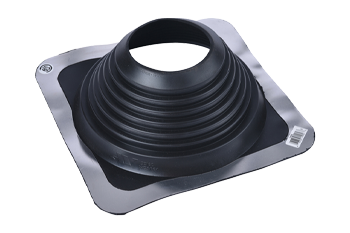
Side (Vertical) Flashings
Explicitly designed for vertical installation through outside walls, side flashings ensure a proper seal and prevent water intrusion. Oatey Sideflash Vertical Flashings features a rigid plastic panel with an elastomeric collar that seals around the pipe. It is designed to be installed over the house wrap or building paper to become part of the building envelope.
Solar Flashings
Solar flashings are specialized components used to integrate solar panels seamlessly into the roof and ensure a watertight seal, enabling homeowners to enjoy peace of mind as well as energy savings. As solar energy becomes increasingly popular, this reliable and efficient solution protects the roof’s integrity even while supporting the weight of a panel installation.

Rain Collars
Rain collars are a vital component usually made from a durable thermoplastic material, providing excellent weathering and UV exposure resistance.
Rain collars are available in various sizes to accommodate different pipe sizes, ensuring a proper fit that prevents leaks and water damage. Easy to install, they are used to repair existing flashings without affecting the roof shingles.
Specialty (Breather Vents and Frost-Proof Flashings)
Specialty roof flashings, such as breather vents and frost-proof flashings, offer unique features and benefits that address specific roofing challenges.
Breather vents are designed to provide ventilation and prevent moisture buildup in the roof cavity, reducing the risk of condensation and consequent mold growth. These flashings typically incorporate a breathable membrane or mesh that allows air to flow and moisture to escape while keeping out pests and debris.
Frost-proof flashings are specially engineered to withstand freezing temperatures by preventing frost closure of the vent. Featuring insulation or heat-trapping properties, these flashings maintain warmer temperatures to avoid freeze over.
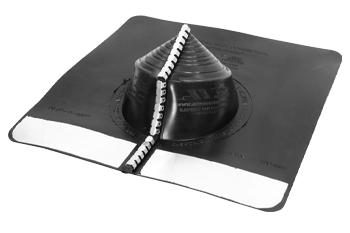
Oatey Electric Mast Connection Master Flash® roof flashing features quick installation time and fire-protection qualities for a long-term fit in a roofing electrical application. Both breather vents and frost-proof flashings are valuable additions to roofing systems, ensuring proper ventilation and protection from poor weather conditions.
What to consider when choosing a flashing
Different roof types require different flashings. For example, only one kind of flashing works effectively with a shingled roof. On the other hand, because the installation process and compatibility differ, a metal roof requires a master flashing.
Below are three essential factors that drive roof flashing selection:
1. Determine the Pipe Size
Knowing the pipe diameter will allow you to choose the flashing size. Oatey offers a variety of flashing collars for every pipe diameter. Additionally, Oatey's flashing collars require no cutting and easily slide over pipes. While this may seem like a minor consideration, it is essential to choose the appropriate size to avoid any complications during the installation.
2. Determine Roof Pitch
Aside from aesthetics, roof pitch determines the suitable flashing. Most standard shingle roof flashings are designed to accommodate roof pitches of up to 45 degrees. The pitch is often indicated by terms like “10/12” or “12/12,” indicating the angle of the roof. For example, a 12/12 pitch means that for every 12 inches of horizontal distance, there is a 12-inch vertical rise, resulting in a 45-degree angle.
If the roof pitch exceeds 45 degrees, a high-riser flashing is recommended. It allows for a greater angle, ensuring a proper seal despite the steeper slope.
Appropriate flashing for the specific roof pitch is vital to avoid unnecessary stress on the rubber collar. Over time, excessive pressure on the flashing can weaken its effectiveness and potentially lead to water seepage.
3. Choose the Base Size of the Flashing
Flashing base size is typically driven by the governing code, so check with your local jurisdiction. To meet specific needs, Oatey offers a variety of base sizes to choose from.
4. Choose Material Type
Oatey offers a variety of base materials: aluminum, copper, galvanized steel, and plastic. The choice is mainly based on personal preference and aesthetics.
Many people select the material based on shingle color to blend the flashing seamlessly into the roof. Others prefer a durable plastic base that is flexible enough to put in their pockets before installation.
5. Determine Any Other Factors
Recognizing other factors that may impact flashing choice is essential. For example, these factors include temperature, UV exposure, and proximity to a saltwater source. As noted, Oatey offers flashings for every scenario: side flashings, solar flashings, or master flashings for metal roofs.
Ultimately, flashing type is primarily determined by roof type, with the pipe diameter and penetration width serving as important considerations, too. Correctly matching the flashing to these elements ensures all the essentials of a professional flashing installation: a secure and watertight seal that prevents potential damage and maintains the roofing system’s integrity.
Some Extra Tips
It is crucial to chamfer the end of the pipe while installing the flashing. This means removing the sharp edge of the pipe to prevent any damage to the rubber collar. If the pipe is not chamfered and the flashing is slid over, it can create microscopic tears in the rubber collar. Over time, the rubber expands due to UV exposure and heat, causing these tears to open and potentially lead to water leakage. To address this issue, separate rain collars can be purchased and slid over the existing rubber collar, using silicone to create a repair.
Chamfering the pipe is an essential preventive measure to avoid these complications. If someone does experience this issue, they can replace the rain collar without replacing the whole flashing. Once installed, the flashing requires no specific maintenance besides the initial chamfering. The flashing’s lifespan and potential repair needs will vary depending on sun exposure, UV radiation, and temperature changes. Any of these makes it difficult to provide a set timeframe for any necessary maintenance or replacements.
Additionally, avoid using petroleum products on the rubber parts of the flashing. While sealing is not necessary for flashings with shingle roofs, as the layering effect of the shingles prevents water from leaking into the house, it’s crucial to not apply tar or any petroleum-based substances on the rubber components. These petroleum products can degrade the rubber over time, leading to cracks and eventual leaks.
But as long as the flashings are installed correctly, and the pipe is chamfered, they both can last a long time. Replacing the rain collar quickly fixes the issue if deterioration occurs after 15-20 years.
